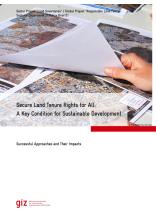Land Library
Welcome to the Land Portal Library. Explore our vast collection of open-access resources (over 74,000) including reports, journal articles, research papers, peer-reviewed publications, legal documents, videos and much more.
/ library resources
Showing items 1 through 9 of 33.Nos últimos anos intensificou-se o debate em torno das relações entre camponeses e a ditadura empresarial militar que se instalou no Brasil em 1964 e descortinaram-se várias questões novas bem como caminhos e fontes de pesquisa sobre o tema.
Government intervention and local level coordination of large-scale investment decisions are important components required for positive impacts on food security, nutrition and livelihoods of host communities.
This article engages recent debates over gentrification and urban displacement in the global South.
This document is the Resettlement Policy Framework (RPF) for the second Lao Road Sector Project Additional Financing (LRSP2-AF, AF, or the Project) and is being proposed for possible financing from the World Bank (WB).
The aim of this policy paper is to present successful approaches to secure land tenure rights in rural and urban areas. To support future programmatic decisions by the Federal Ministry for Economic Cooperation and Development (BMZ), this paper focusses especially on impacts and good practices.
Globally, increased investor interest in land is confronting various types of political mobilisations from communities at the grassroots level. This paper examines the case study of a land occupation movement called Chengara struggle in the largest corporate plantation in southern India.
Smallholders worldwide continue to experience processes of displacement from their lands under neoliberal political-economic governance.
Civil war and violence often force large numbers of people to leave their lands. Multiple waves of displacement and (partial) return generate complex overlapping claims that are not easily solved.
Post-war societies not only have to deal with continuing unpeaceful relations but also land-related conflict legacies, farmland and forest degradation, heavily exploited natural resources, land mines, a destroyed infrastructure, as well as returning refugees and ex-combatants.








